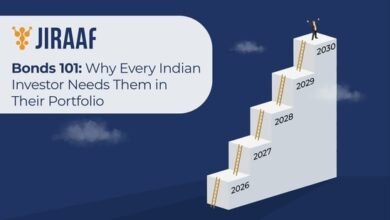The season of true prosperity: Why mixing corporate bonds and equities is smarter than betting all on one

Compare this with corporate bonds, which are fixed-income instruments that pay interest (coupons) regularly and return the principal at maturity or at equal intervals over the investment tenure. Unlike equities, their cash flows are predetermined and not linked to market volatility, making them more predictable than equities. In a year where equities have underperformed, a well-chosen investment-grade corporate bond would likely have delivered positive returns of 8%-15%, depending on credit ratings and tenure, thereby insulating the portfolio from volatility.
Why diversification isn’t just theory, it’s survival
Too many investors fall into the trap of asking, “Which is better: equities or bonds?” Instead, the smarter question is: What mix of assets gives me the best risk-adjusted return for my goals?
* Bond returns vary by borrower. Bonds rated AAA have the lowest risk, while those rated BBB have the highest. Investments in debt securities/municipal debt securities/securitised debt instruments are subject to risks including delay and/ or default in payment. Read all the offer related documents carefully.
Source: NSE, Crisil
An all-equity investor over the last year would have faced pain or stagnation. However, had that investor held a mix of, say, 50% in equities, 40% in corporate bonds and 10% in high-yield fixed deposits, the damage would have been mitigated. The corporate bond component would have delivered relatively stable yields, cushioning the downside, and the high-yield FDs would have granted liquidity, which is essential in volatile times.
Investing is not about picking a “winner” asset class and riding it unthinkingly. It is about balancing growth and stability. Each asset class plays a specific role in your portfolio:
- Investment-grade corporate bonds offer steady, predictable returns, some capital appreciation, and a hedge against equity volatility. They are ideal for short-term and medium-term goals.
- High-yield fixed deposits/ cash equivalents provide immediate liquidity, capital preservation, and the cash buffer needed during volatile times. Parking money in high-yield FDs also allows investors to benefit from market lows as a lump sum.
Only a well-diversified portfolio can give investors steady returns, avoid sharp drawdowns, and compound wealth sustainably.
Deep diversification: Even within bonds, yields and ratings matter
When it comes to investment diversification, most investors are aware of asset allocation and diversification within equity investments. It is a well-attested fact that equity investments should be diversified across various industries, companies, market capitalisations, and other factors. But when it comes to bonds, many investors assume that bonds do not offer the same depth of diversification.
However, contrary to popular belief, the Indian bond market is developing at a healthy pace. Currently, it offers diversification opportunities across issuers, maturities, and credit ratings, enabling investors to optimise returns and manage risk effectively. A well-diversified bond portfolio will consist of different issuers, such as government bonds, PSU bonds, and corporate bonds across different sectors, including banks, NBFCs, manufacturing, FMCG, ecommerce, etc. These holdings would further be diversified across tenure and credit ratings. In the current interest rate scenario in India, it would be advisable to invest in short- to medium-term bonds with a tenure of 1 to 5 years.
A bond’s credit rating determines its risk-return ratio. AAA to BBB-rated bonds are known as investment-grade bonds and can therefore form part of a retail investor’s portfolio. This is what different ratings mean and how they can all fit into your bond portfolio.
- AAA/AA-rated bonds are issued by blue-chip issuers and thus pose the least risk. They also deliver moderate returns, making them ideal for capital preservation while generating regular cash inflows.
Creating alpha in volatile times: The power of bonds in a ₹10 Lakh portfolio
To understand how diversification enhances returns, let’s examine three ₹10 lakh portfolios — conservative, balanced, and aggressive — across varying risk appetites if you had invested in the last 1 year.
Assumptions:
- Starting portfolio: ₹10,00,000
- Period – year (15 Oct’24 to 15 Oct’25)
• Equity return: 0%
• Corporate bonds: - Conservative 9%, Balanced 11.5%, Aggressive 13.5% (applies to the bond portion in each portfolio)
- High-yield FDs: 8%
How diversification created positive returns despite a flat equity market
If an investor had placed the entire ₹10 lakh in equities, their portfolio value after one year would remain ₹10 lakh, since the Nifty 50 delivered ~0% returns.
- The conservative investor earned ₹70,000 in one year, mainly from steady 9% returns on bonds and 8% interest on FDs. Despite having the lowest equity exposure, this investor achieved the highest portfolio return.
- The balanced investor gained ₹62,000, benefiting from a slightly higher-risk bond allocation that delivered 11.5%.
- The aggressive investor, though equity-heavy, still grew their portfolio by ₹48,500 thanks to strong 13.5% returns from the bond portion.
This clearly shows that diversification didn’t just protect against losses — it generated growth even when equities were flat.
The season of prosperity: Why now is a good time to rebalance
Diwali is just around the corner. India is in a season of hope ; macro indicators, consumer sentiment, and earnings recovery point are expected to renew momentum in the Indian economy. But hope and expectations alone cannot drive the equity markets ahead at this valuation. Until we see an improvement in corporate earnings and a broad-based demand revival, the equity markets will likely trade sideways.
As our portfolio examples demonstrate, diversification can yield significant gains even when equities remain flat. The key is to rebalance thoughtfully and capture growth across asset classes.
In this season, investors can do the following with Jiraaf, a SEBI-registered OBPP platform to create an alpha for their portfolio:
- Rebalance for stability and growth: Trim equity exposure after rallies and rotate gains into high-quality bonds or debt, to benefit from fixed returns.
- Harvest yield stability: Retain or add corporate bonds to lock in coupons before rates shift.
- Add Investment-grade bonds: Don’t limit yourself to AAA/AA-rated bonds. Explore A/BB-rated opportunities to optimize growth.
This approach isn’t about predicting market tops; it’s about building resilience, so corrections don’t derail your path to prosperity while still allowing your portfolio to grow even when equity markets pause.
The Nifty 50’s near-zero returns over the past year highlight the risk of single-asset bets. Equity markets can swing both ways, while corporate bonds, with fixed coupons, can provide insulation from equity volatility and provide a reliable counterbalance. Investing isn’t about picking equity or debt; instead, it’s about aligning your risk tolerance, investment horizon, and liquidity needs within a diversified framework.
The conservative, balanced, and aggressive templates offer a starting point. Re-evaluate and reallocate as markets evolve but maintain the core principle of diversification within and across asset classes. In a season of prosperity, it’s the backbone of sustainable wealth building.





